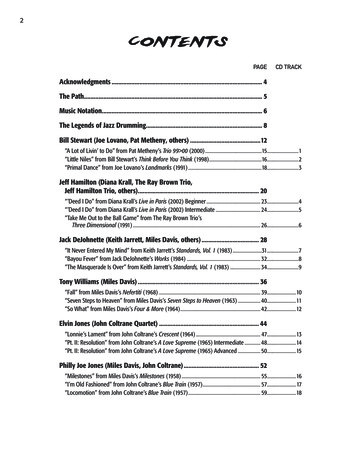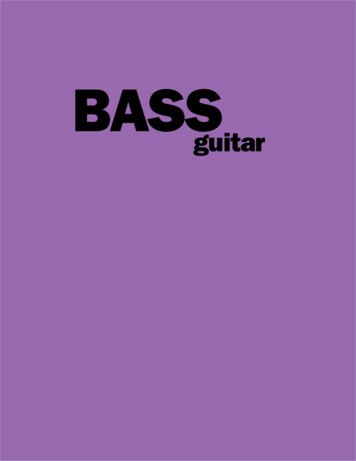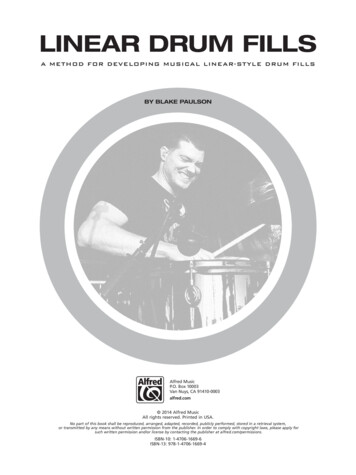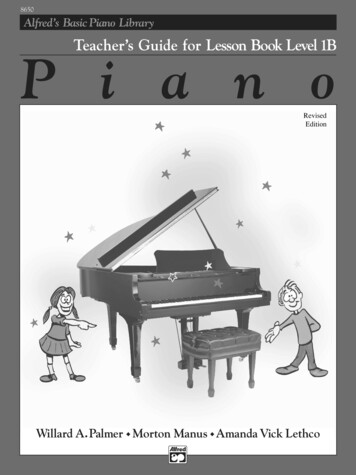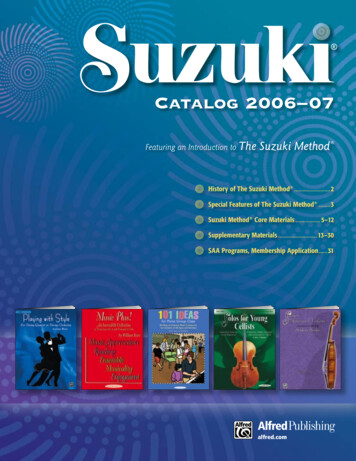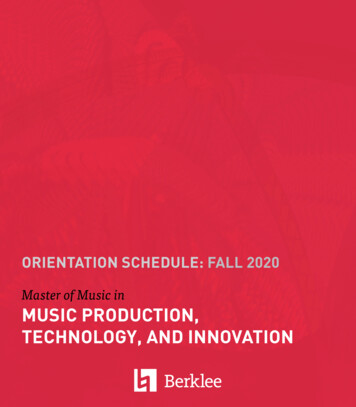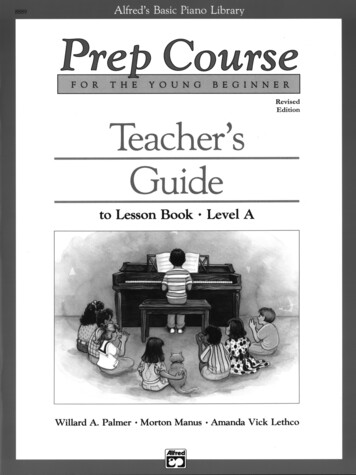
Transcription
Alfred’s Basic Piano LibraryTEACHER’S GUIDEto Prep Course Lesson Book ATO THE TEACHERPURPOSE The purpose of this Teacher's Guide is tosuggest an order of lesson activities that will result ina systematic and logical presentation of the materialin Prep Course Lesson Book A of ALFRED'S BASICPIANO LIBRARY. It gives the teacher considerableflexibility and is intended in no way to restrict thelesson procedures.FORM OF GUIDE The Guide is presented basicallyin outline form. The relative importance of eachactivity is reflected in the words used to introduceeach portion of the outline, such as EMPHASIZE,SUGGESTION, IMPORTANT, OPTIONAL, etc. Whilesuch words are used to indicate the authors' judgmentas to the significance of each item, everything in thebook should fall into the category of suggestedprocedures. Each page in this guide is numberedidentically with Lesson Book A for easy reference.GAPS AVOIDEDBY“OVERLAPS” To ensurePROBLEM-FREE progress throughout the course,and to avoid GAPS that might impede progress, theauthors have used OVERLAPPING CONCEPTSthroughout the course. After a concept has beenintroduced, it continues to be reinforcedsimultaneously with the introduction of new concepts(overlapping concepts).A SOUND APPROACHTOREADING Readingreadiness is developed in carefully paced steps: blackkey groups become the orientation for white-keynames. Rhythm moves from q to h to w, omitting anyconcept of fractions. Large letter-notes on the pagematch the same directional movement that will belearned later on the staff. When the staff isintroduced, the student becomes very skillful withstepwise movement upward and downward as well aswith repeated notes. Skips will be introduced in LevelB. Reading skills are greatly enhanced by the wordschosen for the pieces.INTERACTION On almost every page, there arecomments leading to "Interaction" between theteacher and student at the lesson. Such interaction isvaluable to the teacher in ascertaining whetherspecific concepts actually have been learned.Interaction is valuable to the student because suchfocused discussion and demonstration leads to quickerand more lasting musical development. If the studentis insecure with concepts, the teacher may wish toreview them.DIVISION INTO UNITS AVOIDED Lesson Books inALFRED'S BASIC PIANO LIBRARY are not dividedinto units. This allows the teacher to proceed at thecorrect learning pace of the individual student or ofthe group of students in a class lesson. When thestudent grasps and understands the concepts beingpresented, turn the page!CORE MATERIALS All new concepts are introducedin the Lesson Book. The Lesson Book, Theory Bookand Recital Book form the core of the course andshould be used with all students.THE IMPORTANCE OF SUPPLEMENTARYMATERIALS Numerous supplementary books andmaterials are available to coordinate with the LessonBook and strongly reinforce every musical principle.Teachers should choose supplementary materials tomeet the specialized needs of individual students andintroduce the new materials as recommended in thisGuide. These include the Activity & Ear TrainingBook, Christmas Joy Book, Notespeller and TechnicBook. To heighten interest, Select Music Solos areavailable for use from page 43 on. Mastery of themusical and technical information contained in thecore books, together with the supplementary books,will lead logically, comfortably and pleasurably tofurther musical growth.THE IMPORTANCEOFPRAISE Sincere praisefrom the teacher is one of the most motivating factorsin teaching piano. Praise often accomplishes morethan admonition. Since students learn somethingnew on practically every page of Prep Course LessonBook A, the teacher has the opportunity to remindthem that they are constantly making progress.RECORDINGS A compact disc and a General MIDIdisk are available. Both include a full piano recordingand orchestrated background accompaniment. Theuse of these recordings will aid the student inchoosing appropriate tempos and playing correctrhythms from the very beginning. In addition, therecordings reinforce the important concepts thatconstitute good musicianship. The recordings can beused in the lesson as a “reward” for learning the pieceor at home to encourage practice.The authors hope that this Teacher’s Guide will be asource of ongoing musical pleasure both to teachersand students.WILLARD A. PALMER, MORTON MANUS,AMANDA VICK LETHCOCopyright MCMXCIX by Alfred Publishing Co., Inc.All rights reserved. Printed in USA.
2
3THE FIRST PIANO LESSONThe first lesson requires careful planning and pacing.An ideal goal would be for the student to cover allmaterial as far as page 11 in the first lesson.Students who achieve this goal will go home with anintroduction to the following: Posture at the keyboard Fluent response to finger numbers Use of a little weight when dropping into a key tomake soft tonesNOTE: This is not a method of playing by FINGERNUMBERS! By beginning on the BLACK KEYS, thestudent learns fluent response to finger numberswithout associating any number with any specificKEY, black or white!BLACK KEYS are used as a beginning for thefollowing reasons: They “stick up” above the white keys and are easilyfound with eyes on the music, or even with the eyesclosed. Fingers curve easily on black keys. Use of more weight when dropping into a key tomake louder tones Black-Key groups make tuneful beginning pieces. Importance of playing with a rounded hand Black-Key groups will be used as the basis forlearning letter names of white keys. Awareness of Right hand and Left hand Concept of stepping up and stepping down thekeyboard Concept of low sounds and high sounds Recognition of groups of 2 black keys and 3 blackkeys qandh Bar lines Measures Double bar at end of piece “Sing Along!” (for left hand) “End of Song” (for right hand)Some of the pages from page 4 to 11 should be taughtquickly. This Teacher’s Guide will give suggestions forpresenting those pages that require special care andemphasis.IMPORTANT! At the first lesson, the following cannotbe overemphasized: Play with a rounded hand. Count aloud. Keep eyes ON MUSIC. LISTEN!These concepts become progressively more difficult ifneglected in the beginning. Avoid the necessity forremedial teaching in later lessons, after poor habitsare formed.
4GOALS Understanding andobserving good postureat the keyboard. Beginning to build agently rounded hand.KEY WORDS Sit tall! (A positivestatement is preferableto a negative one, suchas “Don’t slump.”) Arms hang loosely fromshoulders. (Relaxingshoulders preventstension in the arms.Lack of tension resultsin more beautiful tones.) Knees slightly under keyboard (for more armfreedom). Feet flat on a book or stool if student’s feet do notreach the floor (for security and balance). Curve your fingers! Curved fingers make it easierto play the piano. A rounded hand is helpful incontrolling tone and in playing smoothly. Hold the bubble gently! It is never too early todevelop playing without stiffness.INTERACTIONStudent reviews the posture points and demonstrateseach one, with the teacher’s help, if necessary.Student demonstrates the rounded hand position: In the lap. On a book. On the keyboard.MORE INTERACTIONStudent holds fingers straight. All fingers havedifferent lengths. Playing with fingers of differentlengths would be like trying to walk with legs ofdifferent lengths. When fingers are curved, lengthsbecome equal!SUGGESTED ASSIGNMENTS Pages 2–3 of Theory Book A.
5GOALS Preparation to ensuresuccess in first effortsat playing by helpingthe student learn to calleach finger into playat will. To make the studentaware of loud and softtones and how they areproduced. To teach the student toLISTEN. To continue building arounded hand.EMPHASIZEMoving fingers in the air in response to numbersasked for. This skill will make first efforts at playingeasier.ALTERNATE GAMESimon says, “Wiggle 2s,” etc.SUGGESTED ASSIGNMENTSIMPORTANT Pages 3–4 of Activity & Ear Training Book A.A little time spent here may save much time later. Pages 4–5 of Theory Book A.KEY WORDSDrop into key. Little weight soft tone. More weight louder tone. (For first efforts, have student playslowly in order to “feel” the difference, dropping intothe key with a little weight and then withmore weight.LISTENBefore you play any key, decide how you want it tosound. Do the tones sound as intended?SUGGESTIONLet the student observe the hammer striking stringsas you play a key (if construction of the pianopermits).INTERACTIONStudent and teacher take turns calling out somefingers to wiggle. Student makes some soft tones onrandom keys, then some louder tones.
6Proceed as rapidly aspossible on this page!GOALS To identify 2-black-keygroups. To gain a fluentresponse to fingernumbers 2 and 3. To understand conceptof HIGH notes andLOW notes.SUGGESTIONHold a page of paper overthe black keys, leavingonly the white keysshowing. All the white keysnow look alike. Remove the paper. The keyboard nowlooks different, and groups of 2 black keys are easy tofind.IMPORTANTBlack keys are used as an introduction to teachingkeyboard topography. Because they begin playing onblack keys, students will always feel at ease playingblack keys. Two black keys are first played together,then separately.EMPHASIZEWe go DOWN the keyboard to the LEFT. We go UPthe keyboard to the RIGHT.CONTINUING We STEP DOWN to neighboring keys withneighboring fingers: LH 2, 3. We STEP UP to neighboring keys with neighboringfingers: RH 2, 3.POINT OUTThe elephant is making low sounds with his trunk.The mouse is making high sounds on the flute.INTERACTIONThe student plays a STEP DOWN on several groupsof 2 black keys (LH finger 2, then 3). Student playsa STEP UP on several groups of 2 black keys(RH finger 2, then 3). Student plays several LOWnotes. Student plays several HIGH notes.SUGGESTED ASSIGNMENTS Page 5 of Activity & Ear Training Book A. Pages 6–7 of Theory Book A.
7Proceed as rapidly aspossible on this page!GOALS To identify 3-black-keygroups. To gain a fluentresponse to fingernumbers 2, 3 and 4 indifferent keyboardareas and to avoidassociating any fingerwith any key.EMPHASIZE“Next-door” keys areplayed by “next-door”fingers: 2, 3, 4.PRACTICE SUGGESTIONWithout playing the notes, move from one group of 3black keys to the next. (This gesture develops ease inmoving over the keyboard.) Do the same with groupsof 2 black keys.INTERACTIONThe student plays a STEP DOWN on several groupsof 3 black keys (LH finger 2, then 3 and 4). Studentplays a STEP UP on several groups of 3 black keys(RH finger 2, then 3 and 4).SUGGESTED ASSIGNMENTSINTERACTION Page 6 of Activity & Ear Training Book A. Student plays a low note from a group of 3 blackkeys, then a low note from a group of 2 black keys. Pages 8–9 of Theory Book A. Student plays a high note from a group of 3 blackkeys, then a high note from a group of 2 black keys. Student says “Go-ing down” while moving down thekeyboard playing all 3 black keys at once withLH 2, 3, 4. Student says “Go-ing up” while moving up thekeyboard playing all 3 black keys at once withRH 2, 3, 4.POINT OUTThe elephant is making low sounds and the mouse ismaking high sounds.
8CD 1GM 1 (33)*Teaching q here (thenlater h and ) movesfrom small to largernote values, thuseliminating the need tothink in fractions.wGOALS ANDOVERLAPPINGCONCEPTSShow the student thatfour new things are beinglearned: bar line,measure, q and counting.Other things are beingreviewed: left hand, lownotes, group of 2 blackkeys and the response toLH finger numbers 2 and 3.INTERACTIONThis concept of overlapping new information withinformation already grasped is a most importantteaching technique followed in Alfred’s BasicPiano Library.KEY WORDS Bar lines divide equal measures of fourthis piece.q s in Note-stems DOWN for LH notes. LH fingernumbers are under the note head. The words to the song tell the student veryimportant information. “Left hand playing,Hear the low notes!”The student claps and counts eight q s. Use anycounting system you prefer. The student plays “LeftHand Playing” in the air, moving 2 and 3 as indicated.(“Choreography” in the air is a useful technique thatprepares for later success on the keys.) Student pointsto bar lines and says how many q s are in eachmeasure.SUGGESTED ASSIGNMENTS Pages 7–8 of Activity & Ear Training Book A. Flash Card 1. Page 10 of Theory Book A.NOTEIt is always good to have the student sing the lyricswhen the words help teach the concepts. When thestudent is shy about singing, the teacher cansing along.POINT OUTLeft hand plays on the left page. The bears areholding up their left arms. Ask the student to hold uphis or her left arm.*Next to the GM icon is the corresponding Type 0 filenumber and, in parentheses, the Type 1 file number.
9CD 2GM 2 (34)OVERLAPPINGCONCEPTS qRhythm Bar lines RH 2-black-key group High notesGOALS To develop fluentresponse of RH fingers2 and 3. To introduce the doublebar at the end ofthe song. Student keeps eyes onthe music while playing.SUGGESTED ASSIGNMENTS Page 9 of Activity & Ear Training Book A.KEY WORDS Double bar line. Note-stems UP for RH notes. Eyes on music.IMPORTANTThe words of the song continue to tell the studentimportant information. “Right hand playing, Hear thehigh notes!”INTERACTIONThe student tells the teacher what is different aboutthe last bar line in the piece. The student claps andcounts “Right Hand Playing.” Use any countingsystem you prefer. The student should understandthat pages 8 and 9 combine to make one song.OBSERVATIONAsking questions is the way to discover exactly whatthe student has grasped. Review may be necessaryand will result in smoother progress.NOTERH plays on the right page. The bird is conductingwith his or her right wing. RH finger numbers areabove the note heads. Page 11 of Theory Book A.
10CD 3GM 3 (35)OVERLAPPINGCONCEPTS qRhythm Bar lines LH 3-black-key group MeasuresGOALS To continue to developfluent response to LHfinger numbers 2 and 3,with the addition offinger number 4. To use LH fingers in anew position to avoidthe association of any finger number with any key. To introducehEMPHASIZEThe student must feel the inner pulse on h s. Thisconcept may be taught by adding an extra armgesture on the inner pulse when clapping h s. Useany counting system you prefer. The student clapsonce for each note, NOT for each count.IMPORTANTLH plays on the left page. The words tell the studentimportant information: “Left hand plays.”INTERACTIONThe student tells the teacher which notes in “SingAlong!” are q s, and which are h s. The student clapsand counts the rhythm in “Sing Along!”SUGGESTED ASSIGNMENT Page 10 of Activity & Ear Training Book A. Flash Card 2. Page 12 of Theory Book A.
11CD 4GM 4 (36)OVERLAPPINGCONCEPTS qqhRhythm 3-black-key group Double BarGOALS To continue to developfluency in RH fingernumbers 2 and 3, withthe addition of fingernumber 4. To use RH fingers in anew position to avoidthe association of anyfinger number withany key. To complete the song begun on page 10.IMPORTANT Page 11 of Activity & Ear Training Book A. Page 13 of Theory Book A.The rhythms on pages 8–11 combine to prepare forpieces to come:qqqqSUGGESTED ASSIGNMENTS q q hEMPHASIZEThe words to the song help the student remember thedefinition of Double Bar: “End of Song!”INTERACTION The student points out the similarities of “SingAlong!” and “End of Song!” The student claps and counts the rhythm ofboth pieces. RH plays on the right page.POINT OUTThe mice are reaching out with their right paws.
12CD 5GM 5 (37)OVERLAPPINGCONCEPTS The rhythm of the firsttwo measures of thispiece combine therhythm of “Left HandPlaying” (page 8) with“Sing Along!” (page 10):page 8 page 10qqqq qqh page 12qqqq q q h No new finger numbersare introduced.GOALS To begin a familiar song on 3 black keys. To continue developing LH finger responses. To review familiar rhythms. Rhythmic stability and fun when played as a duet!EMPHASIZEPlaying indicated finger numbers is EASY.Neighboring fingers play neighboring keys.Repeating finger numbers play repeating keys.POINT OUTThe page on the LEFT SIDE of the book is playedwith the LH. The boy in the boat is pointing with hisleft hand.IMPORTANTThe student should clap the rhythm with loose, freegestures, keeping a steady beat. Check to be sure thestudent feels the inner pulse on h s.INTERACTIONThe student plays “Merrily We Roll Along” in the air,using correct fingers and rhythm. It may also beplayed silently on the fallboard of the piano.SUGGESTED ASSIGNMENTS Page 12 of Activity & Ear Training Book A. Pages 2–3 of Christmas Joy Book A.
13CD 6GM 6 (38)OVERLAPPINGCONCEPTS Reviews rhythms ofprevious pages. Reviews fingernumbers of previouspages. Reviews Double Bar.GOALS To complete the songbegun on page 12. To continue to developRH finger numberresponse. To introduce one newconcept:(count wholenotes by any system you prefer).SUGGESTED ASSIGNMENTSSUGGESTION Pages 4–5 of Christmas Joy Book A.The student may tap the rhythm of “O’er the DeepBlue Sea” using a loose fist tapping across his or herupper chest. Also have the student repeatedly clapand count aloud on the patterns in this song. Flash Card 3.wPOINT OUT The page on the RIGHT side of the book is playedby the RH. The top bird is flapping his/her right wing; thebottom bird is saluting with his/her right wing.CONCLUDINGPlay the duet after the student is secure on notesand rhythm.RECOMMENDEDThe student may bring a cassette recorder to the nextlesson so the teacher can record the duet part.Subsequent duets may be added to each lesson. Thisway, at each practice session the student will reviewall pieces with duet parts. It’s fun! Each piece shouldalso be practiced without the duet part, because allthe pieces are attractive solos as well. Page 13 of Activity & Ear Training Book A Pages 14–15 of Theory Book A.
14CD 7GM 7 (39)OVERLAPPINGCONCEPTS Reviews rhythm of“Merrily We Roll Along”and also stresses theunderstanding of h s.GOALS Secure finger numberresponse of LH2, 3 and 4. Steady rhythm, feelingthe inner pulse on h s. To introduce dynamicsigns: (piano) and(forte).fp Understanding the wordDYNAMICS.CONCLUSIONProceed to the next page, if practical.EMPHASIZE Dropping into a key with less weight formore weight for .fp,SUGGESTIONThe student finds a 3-black-key group without lookingat his or her hand.PROCEDUREThe student claps quietly for the first two pianomeasures, and claps loudly for the last two fortemeasures, always in rhythm.When clapping the rhythm of “Hand-Bells,” clap andswing on half notes (on the second count of h , swingthe arms while holding the palms together). Thishelps the student feel the inner pulse on h s.POINT OUTMusic for the LH is on the LEFT PAGE. The boy isholding the bell in his LEFT HAND.INTERACTIONThe student points to the piano sign and defines it,then points to the forte sign and defines it. Thestudent plays some random black keys piano andother random black keys forte.SUGGESTED ASSIGNMENTS Page 14 of Activity & Ear Training Book A. Flash Cards 4–5. Page 16 of Theory Book A.
15CD 8GM 8 (40)OVERLAPPINGCONCEPTS Applies principles ofpage 14 to RH. Reviewsw Reviews dynamic signsand .pfGOALS Introduces therepeat sign PROCEDURESame as for “Hand-Bells”for LH.POINT OUTMusic for the RH is on the RIGHT PAGE. The girl isholding a bell in her RIGHT HAND.INTERACTION The student points to and tells what it means.The student rings some low bells with LH 3 on themiddle black key of the lowest 3-black-key group,then some high bells with RH 3 on the middle blackkey of the highest 3-black-key group. Thisstrengthens concepts necessary to the locating andnaming of white keys in later lessons. Use of 3rdfinger to ring bells helps review the rounded-handconcept and matches the hand position used onthese two pages. The student claps the rhythm quietly for measures1 and 2, then claps the rhythm loudly for measures3 and 4.CONCLUDINGPlay the duet with the student, observing the repeatsign. Always check for good posture and roundedfingers!SUGGESTED ASSIGNMENTS Page 15 of Activity & Ear Training Book A. Flash Card 6. Pages 4–5 of Solo Book A. Page 17 of Theory Book A.
16This page begins a newsection in which thestudent learns fluentrecognition of whitekey names (in relationto black-key groupsand through the use ofletter notes).GOALFluent recognition of eachA on the keyboard.EMPHASIZEEach A is quicklyrecognized from itsposition in relation togroups of 3 black keys.(This concept has been carefully introduced,beginning with page 6.)SUGGESTED ASSIGNMENTS Page 16 of Activity & Ear Training Book A.SUGGESTION Page 2 of Notespeller Book A.Have the student close his or her eyes and visualizehow A looks (between the 2nd and 3rd black keys inany group of 3 black keys). Page 18 of Theory Book A.EMPHASIZEThe LOWEST key on the piano is A.POINT OUTThe carrots in the illustration make the letter A!INTERACTIONThe student plays each A on the keyboard saying,“A, between the 2nd and 3rd black keys in the groupof 3 black keys.”
17OVERLAPPINGCONCEPTSKeyboard topography hasbeen well establishedthrough actual playing onthe 2- and 3-black-keygroups. Because of this,students easily grasp theidentification of whitekeys by their positions inrelation to the black-keygroups.The concept that notessound higher and higheras they go higher on thekeyboard is alsoreinforced on this pagewhen the student plays andnames every white key going up the keyboard.GOALS Thorough understanding of the use of the musicalalphabet, ABCDEFG. Ease in recognition of any white key from itsposition in or near a black-key group. Freedom in moving from any white key to adifferent white key with the same name. Naming and playing every white key on the piano.PROCEDURECall attention to the position of each white key inrelation to its own 2- or 3-black-key group. Movethrough the musical alphabet.Have the student quickly name and play all the keyson the piano. Use LH 3 to play notes below Middle C.Change to RH 3 at Middle C. Use of the 3rd fingergives the student an opportunity to check for a wellrounded hand.SUGGESTIONAfter following the above procedure, have the studentidentify white keys in random order, first in relationto 2-black-key groups, then in relation to 3-black-keygroups; for example, C, E, D, then F, B, G, A, thenreverse the order.POINT OUTThe illustrations help reinforce the letter names andlocations of the white keys: Apple, Boy, Cat, Dog,Easter Egg, Frog, Girl. These pictures are fun for thestudent!IMPORTANTFlash cards may be used to particular advantagehere. Students should use them for daily drills athome. Emphasize immediate recognition of eachwhite key after only a fleeting glance.SUGGESTED ASSIGNMENTS Page 17 of Activity & Ear Training Book A. Flash Cards 7–13. Page 3 of Notespeller Book A. Page 19 of Theory Book A with pages 17–18.
18CD 9GM 9 (41)OVERLAPPINGCONCEPTS Rhythm vocabulary isthe same as in previouslessons. Review of pianodynamic sign. Review of LH fingering lowerthan notes.GOALS Letter notes are used toteach the key names ofA, B and C in theMiddle C position.NOTESUGGESTED ASSIGNMENTSKey names are now used in alphabetical order,beginning with the first letter, A. Only three keys areused in the LH, employing the fingers that are easiestto use, 3, 2, 1. Page 18 of Activity & Ear Training Book A.PROCEDUREReview and emphasize the four steps for teaching andpracticing each new piece.INTERACTIONThe student plays “A Mellow Melody” saying notenames and observing . The student plays “AMellow Melody” counting aloud.IMPORTANTCheck for a rounded hand when the student playswhite keys!POINT OUTClouds in the picture form A, B, C.CONCLUDINGPlay the duet with the student as he or she says theletter names of the solo part. Page 4 of Notespeller Book A. Page 2 of Technic Book A.
19CD 10GM 10 (42)OVERLAPPINGCONCEPTS Review of rhythmpattern used by LH in“A Mellow Melody.” Review of fortedynamic sign. Review of C in MiddleC Position, now playedby RH 1. Review of RH fingering higherthan notes.GOALS Letter names are usedto teach the key names ofD and E in Middle C Position.SUGGESTED ASSIGNMENTS Counting aloud while playing. Use any countingsystem you prefer. Page 5 of Notespeller A. Page l9 of Activity & Ear Training Book A. Pages 6–7 of Solo Book A.NOTE Key names continue to be dealt with in alphabeticalorder, overlapping Middle C, which was played byLH 1 in “A Mellow Melody.” RH employs the easiest fingers to use: 1, 2, 3.INTERACTIONSame as for “A Mellow Melody.”CONCLUDINGPlay the duet with the student as he or she says theletter names of the solo part. Page 3 of Technic Book A. Page 20 of Theory Book A with pages l9–21.
20CD 11GM 11 (43)OVERLAPPINGCONCEPTS Rhythm patterns RH stems up (conceptintroduced on page 9). LH stems down(concept introduced onpage 8).GOALS Alternate use of handswithin one piece. Stem up and stemdown concepts are nowcombined in one piece. No new notes are introduced.SUGGESTED ASSIGNMENTSINTERACTION Page 20 of Activity & Ear Training Book A withpages 20–21. Student points to RH notes and says “Right” foreach note. Page 6 of Notespeller Book A. Student points to LH notes and says “Left” foreach note. Student says letter names of measures 1 and 2many times, then letter names of measures 3 and 4many times. Student says letter names of all 4 measures. Student taps and counts the rhythm of all4 measures. Student plays “Come and Play!” in the air, beingsure to keep the rhythm steady. Student plays the piece. Play the duet with the student as he or she countsaloud. Page 8 of Solo Book A with page 20 or 21.
21CD 12GM 12 (44)OVERLAPPINGCONCEPTS Rhythm patterns. Same letter notes aspage 20. Alternate use of hands.GOALS Extended use of fingers1, 2, 3 in RH. Extended use of fingers1, 2, 3 in LH. The first approach toplaying faster: “Howfast can you play it?” To play one octavehigher than written for the duet.IMPORTANTAs always, a rounded hand and curved fingers makethis piece easier to play. It is FUN to say the wordsfast and play the piece fast at the same time!INTERACTION The student plays the notes on a book or table withthe correct rhythm. Gradually increase the speedon each repetition of the piece. Ask the student to point to things on the score thathave been in other pieces. Can the student definethe familiar elements? Perhaps the teacher willneed to help.NOTEThe rubber bumpers on the baby buggy!CONCLUDING Play the duet with the student. Stress theimportance of keeping the rhythm steady, eventhough the tempo of the piece is faster thanother pieces. Playing one octave higher than written for the duetis a new experience that adds to the student’sfreedom at the keyboard.SUGGESTED ASSIGNMENTS Page 7 of Notespeller Book A. Page 4 of Technic Book A.
22CD 13GM 13 (45)OVERLAPPINGCONCEPTS The student proceedsfrom the three keys ineach hand used in“Tongue-Twister,”adding only one newkey for each hand:LH G and RH F. Alternating twomeasures of RH withtwo measures of LH.GOALS44 Understanding andcomprehension oftime signature. Extending Middle C Position to include G in LHand F in RH.INTERACTIONThe student points to the time signature and defines it. Continued experience with letter notes, whichinclude every key in the musical alphabet.CONCLUDINGNOTEPlay the duet as the student says note names.Observe . Check for rounded hand.The student moves from “known keys” to the newones, using fingers 1, 2, 3 before playing 4.IMPORTANTThe student will enjoy the “woofs” in the duet part!SUGGESTIONReview the location of all letter notes in relation togroups of black keys.CONTINUINGThe student writes counts in the music, using anycounting system you prefer. Have the student add upthe note values in each measure of “My Clever Pup.”EMPHASIZEAfter “measuring” 4 counts, we have a bar line.KEY WORDS44 Time Signature.REMEMBERUse any counting system you wish.SUGGESTED ASSIGNMENTS Page 21 of Activity & Ear Training Book A. Pages 6–7 of Christmas Joy Book A. Flash Card 14. Page 8 of Notespeller Book A. Page 9 of Solo Book A with page 22 or 23. Page 5 of Technic Book A. Pages 21–22 of Theory Book A.
23CD 14GM 14 (46)OVERLAPPINGCONCEPTS 44 time signature. Alternating 2 measuresof LH with 2 measuresof RH. No new letter notes. No new rhythms.GOALS Continued fluency inchanging from onehand to the other.44 Continued experiencewith .PROCEDURE4 Review the definition of 4 .SUGGESTED ASSIGNMENTSINTERACTION Page 9 of Notespeller Book A. Student claps the rhythm at piano dynamic level. Page 23 of Theory Book A with pages 23–24. Page 22 of Activity & Ear Training Book A.44 Student claps one measure of , taking turns withthe teacher clapping one measure. Continue forseveral rhythm exchanges between studentand teacher. Student says letter names of “Kitty Cat” whileclapping the rhythm quietly. Student writes counts in the music.IMPORTANTThe student will enjoy the “meows” in the duet part.
24CD 15GM 15 (47)OVERLAPPINGCONCEPTS Rhythm patterns. Change from RH to LH. Previously learned keysare used in each hand(LH: C–F, RH: C–G).GOALS Adding one new key foreach hand: RH G andLH F. This addition ofanother note at eachend of Middle Cposition puts all fivefingers of both handsin use. Alternating hands in the same phrase.SUGGESTED ASSIGNMENTS Page 23 of Activity & Ear Training Book A. Page 10 of Notespeller Book A.IMPORTANT Student moves from “known keys” to new ones,playing fingers 1, 2, 3, 4 before adding 5. Student plays “Roller Coaster” in the air.PROCEDURE Student plays “Roller Coaster,” saying letter notesin rhythm. Student writes counts in the music.POINT OUT The shape of the roller coaster in the picture followsthe direction of the notes in the piece!OPTIONALPlay “Roller Coaster” fast!CONCLUDINGPlay the du
PIANO LIBRARY. It gives the teacher considerable flexibility and is intended in no way to restrict the lesson procedures. FORM OF GUIDE The Guide is presented basically in outline form. The relative importance of each activity is reflected in the words used to introduce each portion of

